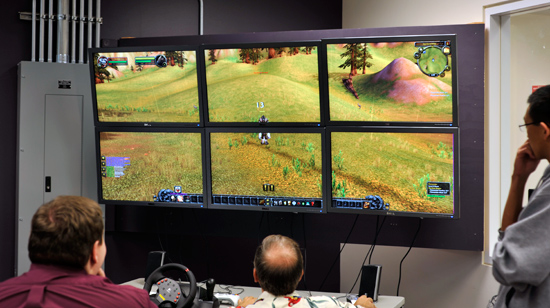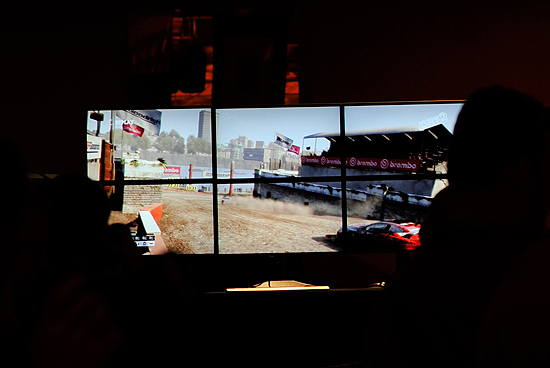Beginnings of the Holodeck: AMD's DX11 GPU, Eyefinity and 6 Display Outputs
by Anand Lal Shimpi on September 10, 2009 2:30 PM EST- Posted in
- GPUs
The First Generation Holodeck by 2016
When AMD first told me about the RV770 they told me another interesting story. For the past several years AMD (and ATI before it) has been obsessed with trying to figure out when it would be possible to render an image so convincing that it was indistinguishable (at least mostly) from reality.
Given the right art and a good technique to render the scene, this is totally possible not only within our lifetimes but within the next decade. Unfortunately, that's not enough.
Carrell estimates that the human eye can directly resolve around 7 million pixels, almost twice the resolution of a 30" display. But that's just what it's directly focusing on, all of the peripherial vision brings the total up to around 100 million pixels. The Eyefinity demo I showed earlier was running at 24.5 million pixels on a single GPU; you can estimate that at this generation we'll be able to do about 50 million pixels with two GPUs and one more generation from now we'll get to that 100 million pixel marker. That's two years for a single GPU. Then give it a few more years to be able to render that many pixels but with enough complexity to actually look real.
Rendering something at the max resolution that the human eye can resolve isn't enough however; you have to feel immersed in the graphics. That's where Eyefinity comes in, at least what it starts to come in.
Carrell believes that in seven years we can have the first generation Holodeck up and running. For those of you who aren't familiar with the Trek reference, Carrell believes it'll take seven years to be able to deliver a 180 degree hemispherical display (you're not completely surrounded by displays but at least your forward and peripheral vision is) with positionally accurate and phase accurate sound (both calculated by the GPU in real time). The GPU will also be used to recognize speech, track gestures and track eye movement/position.
It doesn't solve the issue of not being able to walk forward indefinitely, but again this is only the first generation Holodeck.
Eyefinity isn't anywhere close, but if you understand the direction: it's a start.

We're at six 2560 x 1600 displays today, is it too far fetched to imagine a totally immersive display setup that renders at life-like resolutions?
First person shooters pretty much dictate that you'll need an odd number of displays to avoid your crosshairs spanning multiple monitors. With three displays you can begin to get the immersion effect, but buy five and you'll be completely surrounded by your game. And as I mentioned before, it doesn't require any special application or OS support, the drivers take care of everything: it just appears as a single, large, surface.
It seems trivial but honestly we haven't had the ability to easily support the ridiculous display setups we always see in sci-fi movies. Eyefinity at least makes it look like we can build the PCs from the Matrix.
Will it succeed? Who knows. Does it sound gimmicky? Sure. Is it cool? Yeah, I'd say so.

If panel prices could drop significantly enough where putting together an Eyefinity display setup didn't cost more than the graphics card, I think it'd be a much easier sell. Obviously AMD's next-generation GPU is more than just Eyefinity, but you'll hear about the rest late this month.










137 Comments
View All Comments
Myrandex - Friday, September 11, 2009 - link
I believe Matrox's Triple Head gaming was supposed to do this, and not just offer a wider resolution. I don't think it had much support, but I do think that Quake III was one title that did support it.Jason
Hlafordlaes - Thursday, September 10, 2009 - link
The setup reminds me of the Phillips Videowall technology of the 1980's. Consisted of a set of rear-projection monitors that could be individually addressed or spanned as one, with a barely visible seam between them that quickly became unnoticeable if you sat and watched a show.We set one up in a retail location, and since it coincided with the VHS boom at the time, we showcased new titles on it, which led to really high sales. Even Monserrat Caballé came to the shop to give a short recital "broadcast" on site. (And, yes, once one disgruntled employee managed to put a truly nasty sex tape on at peak shopping hours). I tell you, we wowed the rubes. But it was mega-$$$a the time.
The Samsung concept display shown in the article looks attractive, and a first step toward getting it right. One can see IMax+3D home theaters in the offing in a few years.
Flyboy27 - Thursday, September 10, 2009 - link
Dude...! $%&* Crysis!Seriously, its not THAT good. Ok for the people that always ask. From now on, yes it will run Crysis, and no you shouldn't give a $%&*.
Pirks - Thursday, September 10, 2009 - link
I doubt it will render Crysis faster than 1 frame per second. Good luck enjoying your focking slideshow :)JimmiG - Thursday, September 10, 2009 - link
Blurry textures, blocky models, leafs and vegetation made out of 2D sprites, and overly shiny, plastic, artificial looking trees and rocks will still look as crappy at 50 megapixels as they do at 1.8 Mp.Especially when combined with cramped levels, repetitive gameplay, dumb AI and a completely non-interactive environment (being able to blow everything to pieces doesn't count).
Pirks - Thursday, September 10, 2009 - link
It'll be 10 or 20 years till they could render Crysis with that 7000x3000 resolution with playable framerates*yawns*
Maybe my son lives long enough to see it... I hope
Griswold - Friday, September 11, 2009 - link
"Maybe my son lives long enough to see it... I hope"I hope you're kidding and not actually breeding...
Pirks - Friday, September 11, 2009 - link
I'll teach him how to taunt you too :Psbuckler - Thursday, September 10, 2009 - link
Well not quite but a lot more advanced then what ati is talking about. It's called a cave. You sit in a large cube, every wall of which has 2 projectors back projecting on to it. Put on the 3d glasses it's like the holo deck in that everything is in 3d and surrounds you.It's used for things like styling cars - designers can make the inside of a new car in cad then sit inside it too see if it really works.
Costs a fortune however and wouldn't fit in the average house :)
jay401 - Thursday, September 10, 2009 - link
It's cool and all, but it makes it like you're playing all your games through a football (gridiron) helmet due to the edges of the monitors intersecting the display.Also, unless you use one of the far right-side monitors as your primary desktop, you'll have that annoying run-off problem with the mouse cursor where it slides over to the display to the right when you just want to click the [X] for the window in your current monitor, just due to our ingrained nature of over-sliding the mouse to the upper-right corner when we want to close a window. :)
Using a left-side monitor as my primary, I can solve this with UltraMon by making my second display not only to the right but LOWER than my primary display, so that the cursor still stops at the upper right edge of my primary display.
I wonder how this system will handle it. Perhaps it will be smart enough or have a setting that allows you to keep the cursor from sliding beyond the right edge of the current screen when a program is maximized on that screen, so that you can hit the [X] easily like you can on a single display setup (or a right-side display in a multi-display setup).